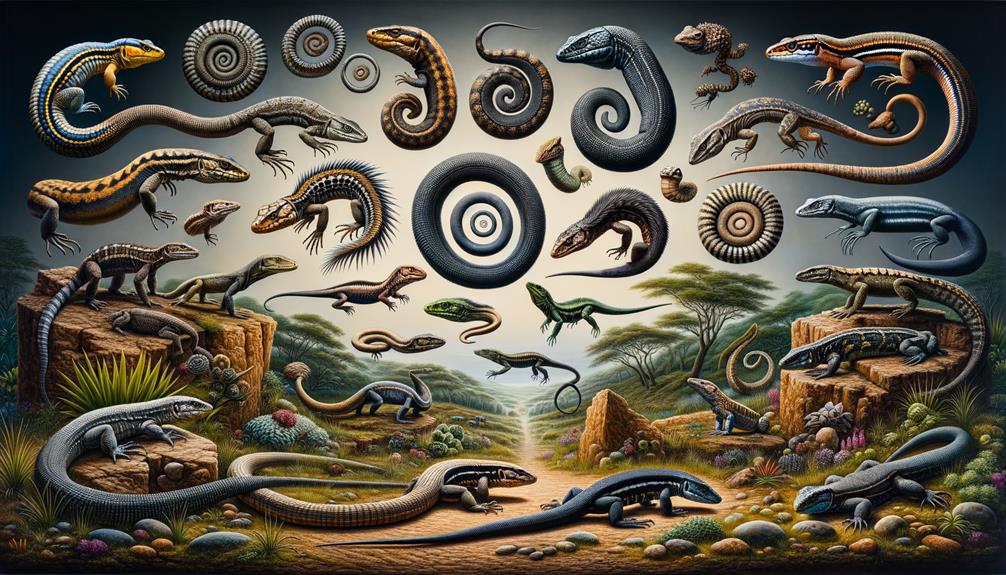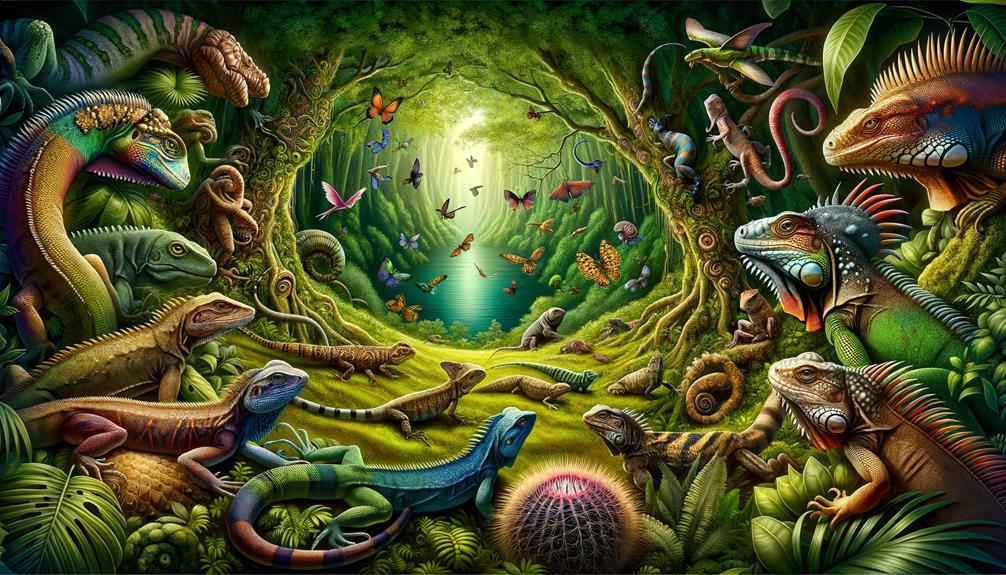I've always been fascinated by the complex ways reptiles communicate with each other. Take chameleons, for instance – they change colors to signal their social status. Snakes, on the other hand, leave behind scents to find potential mates. Crocodiles don't just sit silently; they bellow to attract partners and use eye contact to establish dominance. Anole lizards perform push-ups to mark their territory, while some geckos chirp during courtship. These behaviors reveal a rich and complex social world, giving us a deeper understanding of their interactions. Let's take a closer look at the fascinating details of reptilian communication.
Key Takeaways
Reptiles communicate in various ways to convey vital information. They use color changes, body patterns, and postures to signal their identity, territory, and reproductive status. Chemical signals from skin glands and cloacal secretions also play a crucial role in attracting mates and marking territories. Some reptiles, like crocodilians and geckos, use vocalizations to communicate during mating, territorial disputes, and parental care. Body postures, such as head-bobbing and jaw-gaping, can signal dominance, aggression, or courtship intentions. By understanding how reptiles communicate, we can develop effective conservation strategies that take into account their habitat needs and social structures.
Visual Communication in Reptiles
Visual communication in reptiles is a fascinating behavior that reveals critical information about their identity, territory, and reproductive status. Species like chameleons and geckos use color changes, body patterns, and postures to convey this information.
Chameleons are masters of color change, and it's not just for camouflage. They also use it for social purposes, such as attracting a mate or signaling dominance to rivals. By studying their visual communication, we can gain insight into how they navigate their social world.
Geckos communicate through intricate body patterns and colors. During courtship and territorial disputes, these visual cues can deter rivals and attract potential mates. Observing these behaviors provides a glimpse into the social dynamics within their species.
Anole lizards engage in 'push-up' displays, asserting dominance and attracting mates. This behavior is influenced by environmental factors, highlighting the importance of visual communication in their social interactions.
Even crocodilians use visual cues like eye contact and jaw gaping to signal aggression, showcasing the diverse ways reptiles use visual communication to interact with their environment and each other.
Chemical Signaling Mechanisms

Reptiles rely on intricate chemical signaling mechanisms to communicate vital information about themselves and their environment. These chemical signals can reveal a wealth of details, from species identification to an individual's sex and reproductive status. Specialized skin glands and cloacal secretions are key sources of these signals, producing complex blends that other reptiles can interpret.
Chemical cues play a crucial role in mate attraction, allowing individuals to find suitable partners and ensuring successful reproduction. Territorial marking is another critical function of chemical signals, helping to establish boundaries and avoid conflicts. By leaving their unique scent, reptiles can assert their presence and deter intruders.
Snakes and lizards exhibit a fascinating behavior known as scent-trailing, where they follow chemical trails left by others to locate mates, prey, or navigate their environment more effectively. This subtle yet powerful form of communication underscores the importance of chemical signals in their world.
In essence, skin secretions and pheromones form a vital network of communication for reptiles, guiding their interactions and ensuring survival in diverse habitats.
Auditory Signals and Vocalizations

In the world of reptiles, sound plays a vital role in their communication strategies. By using auditory signals and vocalizations, these creatures can attract mates, establish territories, and even ensure their survival. Among reptile species, crocodilians and certain lizards are particularly notable for their vocal communication.
For instance, baby crocodiles use high-pitched vocalizations to call their mothers for protection, a crucial mechanism in their early stages. Male alligators, on the other hand, are known for their deep, rumbling bellows, which serve two purposes: attracting potential mates and warning rival males to stay away.
Some gecko species have also been found to produce chirping or clicking sounds, which are essential for their courtship displays and territorial assertions. The Cuban knight anole, a lizard that resembles a frog, uses calls as mating signals, demonstrating the diverse range of communication mechanisms used by reptiles.
Each sound, bellow, or chirp in the reptile world is carefully crafted to convey specific messages, allowing these resilient creatures to thrive in their environments. By understanding these auditory signals, we can gain a deeper appreciation for the complex communication strategies employed by reptile species.
The Role of Body Postures

While sounds play a significant role in reptile communication, body postures offer a fascinating and intricate method of conveying messages. Reptiles display a wide range of postures, such as head-bobbing, tail-wagging, and body-raising, each carrying specific meanings within their social structures. For example, lizards use head-bobs and push-ups to signal dominance, territorial claims, and courtship intentions. This social choreography helps us understand their interactions, shedding light on the ecological aspects of their behaviors within the animal kingdom.
Snakes also use body postures to communicate. By coiling, flattening their bodies, or raising their heads, they indicate aggression or defensive stances. These physical cues are crucial for their survival, helping them navigate complex social dynamics and avoid unnecessary conflicts. Similarly, crocodilians employ distinctive postural changes like snout-lifting and jaw-gaping to assert dominance and define territorial boundaries, further highlighting the importance of non-vocal communication in their lives.
Reptiles' body postures convey vital information about their internal states, social status, and motivations to other reptiles. By studying these behaviors, we can gain a deeper understanding of the intricate social structures and ecological aspects that define their existence, adding depth to our knowledge of the animal kingdom.
Implications for Conservation

Understanding reptiles' complex social behaviors and communication methods provides valuable insights that directly inform and improve conservation strategies for these often misunderstood creatures. By studying their signals and interactions, we gather crucial information to protect and preserve them. Over millions of years, reptiles have developed unique ways to communicate, including chemical signaling and body postures that offer clues about their needs and vulnerabilities.
Observing how certain species guard their nests and care for their young reveals the importance of specific habitats and the need to preserve these environments. New technologies, such as camera traps, have uncovered hidden social structures, highlighting the role of family ties in the survival of endangered populations. This knowledge is crucial for developing effective reintroduction programs and managing habitats.
Long-term studies of reptiles' natural social interactions help shape effective conservation policies. By understanding these dynamics, we can mitigate threats like habitat loss and illegal wildlife trade, ensuring these ancient creatures continue to thrive in their natural environments for generations to come. It is crucial to recognize that reptiles are intelligent creatures, capable of complex behaviors, and that this understanding is key to their conservation.
Frequently Asked Questions
Can Reptiles Get Emotionally Attached?
I've seen evidence that suggests reptiles can form emotional attachments. For instance, shingleback lizards form long-term pair bonds, and crocodilians go to great lengths to protect their young. Recent advances in technology have revealed their complex behaviors, challenging the traditional view of them as unemotional, cold-blooded creatures.
Are There Any Monogamous Reptiles?
Some reptiles are monogamous. Shingleback lizards, for instance, form long-term bonds that often last a lifetime. I've observed pairs defending each other and even exhibiting signs of grief when a partner dies, revealing the complexity of their social behaviors.
What 3 Orders of Reptiles Are Still Alive Today?
The three orders of reptiles still alive today are Squamata, Testudines, and Crocodilia. Squamata is the group that includes snakes and lizards, while Testudines is made up of turtles, and Crocodilia covers crocodiles and alligators. Each of these groups has its own unique characteristics that set them apart.
Can Reptiles Sense Fear?
Watching a chameleon shift its colors in response to a distressed insect was a fascinating experience. It made me realize that reptiles can sense fear, which is an incredible ability that helps them navigate and survive in their environment.



